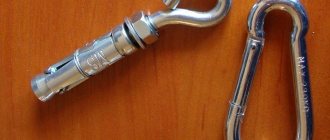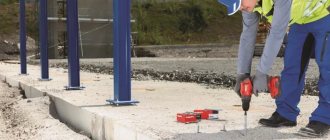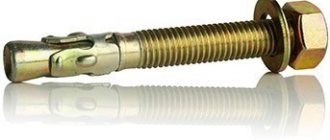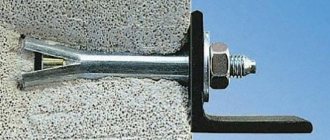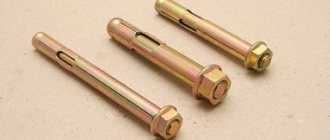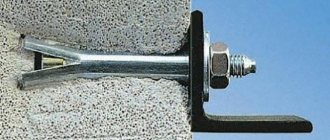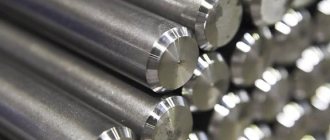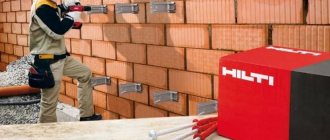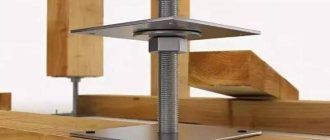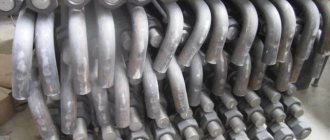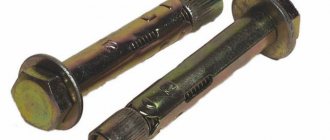There is no uniform standardization for metal anchors, so products that are similar in design, but manufactured by different manufacturers may differ in size, detailed design, material, type of coating and permissible loads. Their load-bearing capacity is determined by the design features and strength class of the materials from which they are made.
When choosing anchor fasteners, you should be guided by the degree of responsibility of the fastening and data from the manufacturer’s technical documentation on the pull-out and shear loads for a specific standard size of the anchor. And during installation, you must adhere to the recommended installation parameters, such as:
- hole diameter in the main and attached material;
- hole depth and anchorage depth;
- minimum thickness of the base base;
- thickness of the element being fixed;
- tightening moment;
- minimum center and edge distances.
Anchor sizes for concrete
Often on the display case you can see the marking of this fastener only by the diameter of the thread and the length of the rod (stud). For example: M20×220. This data is not enough: the “secret” remains the diameter of the drill, the depth of the hole and a number of other information necessary for installation.
You can also find the following marking: M10 12x100. Here the diameter of the hole, i.e. drill (12 mm), is added. But this is not complete information either.
The full marking of the anchors looks, for example, like this: M6 8/40×90, where M6 is the thread diameter, 8 is the drill, 90 is the minimum hole depth, 40 is the maximum thickness of the attached material. Based on this marking, you can already choose an anchor for concrete.
Working principle and application
Concrete is a porous material with a heterogeneous structure. And in the places of fastening, various forces appear - twisting, bending, shearing, shearing, compression, tearing. The concrete anchor takes over them, distributing them together with the supporting structure.
Basic principles of operation of concrete anchors:
Anchors for concrete can be of different designs, types, sizes. They are made from special steel according to GOST and coated with a layer of anti-corrosion agent. The rod can be 6-20 millimeters in diameter and up to 220 millimeters long.
Kawabanga! Polymer paints for concrete
Any anchor includes the following parts:
- The bolt itself
- Cone with a layer of thread inside
- Bushing with special cutouts
Structural fasteners are used to counteract the displacement of parts of the assembly if their stability is guaranteed by their own weight; anchors are also relevant when straightening in construction.
Main characteristics of anchors
The anchor is a steel rod, ranging in size from 45 mm to 200 mm. A characteristic design feature is provided by a sleeve with longitudinal slots and a nut.
In the product name, the first number indicates the diameter of the suitable hole, the second – the length of the fastener itself, and the third – the thread size.
Anchor nail
Simple threadless anchor. Similar to hammers (Fig. 11). The bushing has longitudinal cuts (1) at one end, and a low semicircular flange (2) and a wedging nail (3) at the other. The bushing is installed all the way into the base with the flange facing outwards (Fig. 12). When driving a nail, the split part of the sleeve opens and fastening occurs by friction.
Rice. eleven
Rice. 12
Types of anchors by installation method
Ampoule - is a glass capsule with a two-component mixture and is intended for one-time use. Requires mixing directly in the hole.
Cartridge - the adhesive composition is located in a cylinder and is mixed immediately upon feeding. A special gun is required to insert into the hole.
Some manufacturers produce tubes with a measuring scale, which greatly simplifies the feeding process and eliminates the need for additional tools during installation.
An adjustable anchor is installed under the posts and is able to adjust the horizontal surface relative to the vertical.
Kawabanga! Characteristics of epoxy putty for concrete
Video description
From the video you can find out how the anchor behaves in a load-bearing foundation:
Expanding
This concrete anchor is a petal sleeve with a built-in nut at the end. As a result of screwing in the bolt, the entire body expands, except for the edges. This explains the applicability of the products for working with porous and hollow substrates.
Such fasteners can be dismantled and reused if desired. For through immersion of the pin, the hole for the “anchor” is drilled to a depth with a margin of 20 mm. For the calculation, the length of the sleeve is taken.
Expansion fastener Source www.obudom.com
Frame
These anchors are designed for mounting window frames and door frames. The operating principle of the “anchor” is based on expansion-type hardware. Only the petals are shifted to the lower part of the body. And on the top there are molded stops that prevent rotation and displacement of the sleeve.
Chemical
Such anchors are represented by bolts or studs, which are immersed in a liquid, quickly hardening mass with adhesive properties. As a result, the load on the hardware is distributed evenly along the entire length. This makes it possible to install fasteners in any base: dense, porous, fibrous or hollow.
The working mass of a chemical anchor is a two-component resin of synthetic origin (the second substance is intended to accelerate the hardening of the composition). The advantages of fasteners include the following:
- high connection strength;
- the possibility of eliminating toxic substances from the composition;
- no odor;
- dry residue hardness without thermal expansion;
- applicability for almost any substrate outdoors and indoors;
- hermetic filling of voids in the seat;
- maintaining technical characteristics for more than 50 years.
Dowel made of hardened resin Source kayrosblog.ru
Features of installation of anchors for concrete
The reliability of fastening obtained using an anchor bolt is influenced by a number of factors:
Sequence of installation operations (click to enlarge)
Installation of anchor-type bolts can be carried out in various structures, the material of which must be of sufficiently high strength. These include, in particular:
- concrete foundations;
- walls and partitions made of concrete and brick;
- floor slabs, which are usually made of concrete.
Mechanical anchor installation diagrams
Objects and structural elements that are fastened with such bolts are usually:
Load calculation depending on anchor parameters
As mentioned above, fixing an anchor-type bolt inside a pre-prepared hole can be achieved in two main ways:
- by wedging the spacer sleeve inside the hole;
- due to a special adhesive composition that binds the bolt and the inner walls of the hole (chemical anchor).
There are requirements for holes in the fastened part, which should not exceed the values specified in the table. Large gaps can be filled with mortar
Anchors: their effectiveness and types
The effectiveness of anchor bolts speaks for itself, this is the latest modern device that is quickly gaining popularity due to its ease of use and practicality. At the moment, there are no analogues for them that could compare in terms of economy and physical characteristics. Taking the physical laws of load distribution along a plane as a basis, experts came to a very effective solution and created this device.
Anchor bolts are divided into several types
Anchors come in different types, have approximately the same properties and functions, each has a fundamental difference. They are divided into the following types and subtypes:
- Mechanical: – mortgage; – spacer; – driving; – wedge; – a bolt with a ring or hook; – frame; – hairpin; – façade; – ceiling; – spring.
- Chemical: – monolithic fasteners; – for external and internal work; – for fastening in loose and thin-walled substrates; – resistant to vibrations; – long-serving;
- Plastic.
- Ground.
- For foundation construction.
- Height adjustable.
Choosing the right type is not difficult
Chemical Anchor Bolts for Concrete
The battery-powered dispenser allows you to introduce the adhesive composition quickly and accurately
Procedure for installing a chemical anchor
Thus, for different types of concrete, different types of anchors are provided, the selection of which should be given special attention.
Briefly about the main thing
The concrete anchor bolt is designed for fixing heavy structures and equipment.
Mechanical anchors vary in structure. They can be driven, spacer, wedge, sliding and frame. They are used to work with dense or porous substrates.
Chemical anchors are available as ampoule or injection. The first ones have a glass dowel and a small amount of liquid mass. Suitable for monolithic concrete. The latter are relevant for any base, since the resinous adhesive substance fills almost the entire space of the seat until it begins to harden.
The marking will allow you to decide on the choice of anchors based on size, and the accompanying documentation based on load-bearing capacity.
Types of mechanical anchor connections for concrete
For fastening to a structure made of ordinary dense concrete, a mechanical anchor is most often chosen. The reasons for this are:
In accordance with the listed advantages, all that remains is to choose an anchor for concrete among the manufactured modifications listed below.
Drive-in anchors
During installation, the sleeve is placed in the hole, then pushed deep into it using a special striker. At the same time, the bushing is unclenched, due to which it is secured. Then we simply screw the threaded part into the bushing.
Expansion (expansion) anchors
There is a modification of expansion anchors: double-expansion - with two wedging zones of the expansion sleeve or with two expansion sleeves. This design provides a more secure fastening.
Kawabanga! Mold release agent
Wedge anchors
Wedge anchors are most often used for highly loaded connections.
Another modification of wedge anchors is rod anchors. Its main difference is the increased length of the hairpin. Its purpose is to fasten structures of large thickness.
